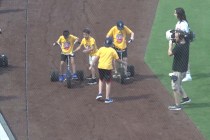New approach to the old ballgame

In the top of the seventh inning, as the two girls stood inside the Cashman Field press box, 51s president Don Logan asked them, “Do you know what ‘pepper’ is?”
The girls, probably 11 or 12, looked at each other quizzically, giggled and said no.
But that was OK, given they had to focus on another tradition. They were waiting for the top of the seventh to end so they could lead the crowd in singing “Take Me Out to the Ballgame.”
And while that baseball tradition endures, others seem to have fallen by the wayside or are headed toward extinction.
When was the last time you saw a team take pregame infield practice? When was the last time you saw a coach wield a fungo bat and hit pop-ups to the catcher or the infielders? Can you remember the last time you went to a doubleheader and were charged only once to go through the turnstiles? How often do you see someone keeping score?
And when was the last time you saw players participate in a round of pepper, a batting and fielding game that usually involves four or five players and helps sharpen one’s hand-eye coordination?
As America celebrates its 237th birthday today, baseball, the national pastime, finds itself moving on from the time-honored traditions that helped shape it. For today’s 11-year-old fan, traditions consist of “walk-up” music when his favorite player comes to bat, “walk-off” home runs, “Calls to the bullpen” sponsored by AT&T or some other corporate tie-in, T-shirts launched into the stands and bobblehead giveaways.
For the grandfather who accompanies that 11-year-old to the ballpark, it’s not the game he grew up with in terms of customs and refreshments. The Fourth of July meant hot dogs and beer, not sushi and a hand-crafted ale. It meant keeping score on a scorecard with a pencil, not checking the iPhone to see who did what.
So what happened?
“The game hasn’t changed,” said Wally Backman, the 51s’ manager, who played 14 seasons in the majors and has a World Series ring as a second baseman with the 1986 New York Mets. “The routines have changed.”
Backman was sitting in the first-base dugout at Cashman Field. He stared out at the empty field, took a long drag on a cigarette and sighed.
“I’m old school,” said Backman, 53. “I miss the old traditions. I miss taking (pregame) infield. I always thought it helped get you mentally ready to play. I miss playing pepper. I was pretty good with the bat.
“All those things — we still do them here. We’ll take (pregame) infield on the road just to get used to the park. I have a fungo bat. But players today prepare differently. They’re watching (video) tape. They’re lifting (weights). They’re working on things in the cage. They still put in the work.”
Certain trends go in cycles
Marty Barrett also played in the 1986 World Series, as a second baseman for the Boston Red Sox. The Las Vegas resident now coaches youth baseball and knows that this generation plays and watches the game differently than he did.
“Baseball goes in cycles, and there’s a higher level of training in baseball now than there’s ever been,” said Barrett, 55, who played 10 major league seasons. “In my day, there were pitching machines during batting practice. You don’t see those anymore. It’s always live pitching.
“I personally enjoyed taking pregame infield. It was a great way to warm up and get your head in the game. I remember how much fun it was to play pepper. You’d be inside Fenway Park, and John Kiley would be playing the organ. It just felt like baseball.”
The Las Vegas Triple-A franchise employed an organist when it began playing as the Stars in 1983. But the live organ music was phased out by the end of the decade, replaced by a steady stream of pop hits, oldies and other canned music.
“We needed the room the organ was taking up for office space,” Logan said.
According to Foxsports.com, 17 of 30 major league teams employ an organist. Instead, you are more likely to hear “Little Talks” from “Of Monsters and Men,” a pop group from Iceland, over the public address system than “Lady of Spain” on the organ. If the person in charge of the canned music wants to wax nostalgic, he’ll break out John Fogerty’s “Centerfield” or Bruce Springsteen’s “Glory Days” — both released in 1985.
Logan, 54, who has been with the 51s since 1984, grew up in Tonopah as a San Francisco Giants fan. He said traditions falling by the wayside are a mere byproduct of changing times.
“People are still going to stand during the seventh-inning stretch; they’re still going to sing ‘Take Me Out to the Ballgame,’ ” Logan said. “But the world wants variety. You can’t do the same thing over and over. You still need to motivate people to come out to the ballpark.”
Which is why the 51s have scheduled a pay-one-price doubleheader July 12 against the Tucson Padres at Cashman Field. In the minor leagues, it’s a little easier to schedule doubleheaders than at the major league level, where the economics are much different.
“Forget about the union,” Logan said of the resistance toward single-admission doubleheaders. “You’ve got all these new parks with luxury boxes and club seats. You’ve got sponsorship packages built on ‘x’ number of dates. Every single date is an event unto itself. You’re trying to maximize revenue. Even if the union agreed to regularly scheduled doubleheaders, the owners wouldn’t want to do it because they’d lose money.”
‘Let’s play two’ phased out
The last regularly scheduled major league doubleheader was July 16, 2011, in Oakland, Calif., where 27,300 showed up to watch the Athletics play the Los Angeles Angels. Ken Korach, the A’s longtime broadcaster who resides in Henderson, worked both games and remembered the nostalgic feel.
“It turned out to be a fun day,” said Korach, 61. “It was part of a throwback promotion as part of an ’80s weekend and the fans were into it.”
Korach, who has been calling major league games for 22 years, the past 18 in Oakland, also does something not seen as often at the ballpark these days: He keeps score in a score book. Of course, he has to. It’s part of his job. But with each passing year, it seems like fewer fans bother to keep track of each pitch, each play.
“Here’s why,” said Logan, who whipped out his smartphone and called up the 51s-Tacoma game that was being played at Cashman. “In a matter of seconds, I can get every play in this game. Same thing for any major league game. And if I want to see a certain play or an at-bat, I can call it up on the phone and watch it on YouTube.”
Korach fears a certain disconnect with the game on the field is developing as fans look to entertain themselves instead of letting the game do it for them.
“I don’t enjoy the parks where you get bombarded by the P.A. system like it was a basketball game instead of baseball,” Korach said. “Baseball is slower by nature, a contemplative game, if you will.
“I remember going to Dodger Stadium, where I grew up, during one of the first interleague years, and I hadn’t been there in many years and the late Bill King (longtime radio voice of the A’s) and I really enjoyed the atmosphere of baseball. It was much more appropriate and tasteful — not the overwhelming noise you hear now. A place like Tropicana Field in Tampa, for instance, is so loud that if you want to talk baseball with a friend, it’s very difficult.”
Balancing past, present and future
Watching pepper or having a fungo bat wielded like Jimmie Reese, Frank Crosetti or Johnny Pesky might be relegated to the early days of spring training, but the game manages to endure and develop its own modern traditions. It could be the “Rally Monkey” in Anaheim, singing “God Bless America” in the middle of the seventh at Yankee Stadium or having the winning team walk through a line and congratulate each other after the final out.
“To me, the passing on of the traditions of the game is very important, and so much of the allure of baseball is how it is all tied together and how the history links the generations,” Korach said.
“I think when fans gain a deeper appreciation for the game, its history, traditions, nuances and understanding of strategy, then baseball’s hold on them will last a lifetime.”
Logan said: “Baseball is trying hard to embrace its past. You see things like the throwback uniforms. That’s pretty cool. When teams like the Yankees and the Dodgers have Old-Timer’s Day, that’s a way to connect the past to the present.
“I think you learn from your past, but you’ve got to keep moving forward.”
Barrett said the game can always reconnect to its past if it wants to. Or needs to.
“All it’s going to take is someone like Bryce Harper or Mike Trout to get a game of pepper going and it will take off,” Barrett said.
And every 11-year-old girl in America who follows baseball will then know what pepper is.
Contact reporter Steve Carp at scarp@reviewjournal.com or 702-387-2913. Follow him on Twitter: @stevecarprj.












